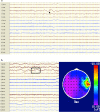Seizures and Epilepsy After Stroke: Epidemiology, Biomarkers and Management
- PMID: 33619704
- PMCID: PMC8007525
- DOI: 10.1007/s40266-021-00837-7
Seizures and Epilepsy After Stroke: Epidemiology, Biomarkers and Management
Abstract
Stroke is the leading cause of seizures and epilepsy in older adults. Patients who have larger and more severe strokes involving the cortex, are younger, and have acute symptomatic seizures and intracerebral haemorrhage are at highest risk of developing post-stroke epilepsy. Prognostic models, including the SeLECT and CAVE scores, help gauge the risk of epileptogenesis. Early electroencephalogram and blood-based biomarkers can provide information additional to the clinical risk factors of post-stroke epilepsy. The management of acute versus remote symptomatic seizures after stroke is markedly different. The choice of an ideal antiseizure medication should not only rely on efficacy but also consider adverse effects, altered pharmacodynamics in older adults, and the influence on the underlying vascular co-morbidity. Drug-drug interactions, particularly those between antiseizure medications and anticoagulants or antiplatelets, also influence treatment decisions. In this review, we describe the epidemiology, risk factors, biomarkers, and management of seizures after an ischaemic or haemorrhagic stroke. We discuss the special considerations required for the treatment of post-stroke epilepsy due to the age, co-morbidities, co-medication, and vulnerability of stroke survivors.
Conflict of interest statement
Dr. Galovic has received fees and honoraria from Nestlé Health Science and Scope International. Dr. Zelano has been an investigator in clinical trials sponsored by Bial, SK Life science, UCB, and GW Pharma as an employee of Sahlgrenska University hospital (without personal compensation) and has received speaker honoraria at educational meetings organized by UCB and Eisai. Dr. Koepp has been an investigator in clinical trials sponsored by Bial, Novartis, Desitin, and UCB and has received honoraria from UCB, GSK, Novartis, Bial, Eisai, Desitin, and GE-Healthcare. Carolina Ferreira-Atuesta, Laura Abraira, Nico Döhler, Lucia Sinka, Francesco Brigo, Carla Bentes, and Johan Zelano have no conflicts of interest that are directly relevant to the content of this article.
Figures





References
-
- Lühdorf K, Jensen LK, Plesner AM. Etiology of seizures in the elderly. Epilepsia. 1986;27:458–463. - PubMed
-
- Seshadri S, Wolf PA. Lifetime risk of stroke and dementia: current concepts, and estimates from the Framingham Study. Lancet Neurol. 2007;6:1106–1114. - PubMed
-
- Jung S, Schindler K, Findling O, Mono ML, Fischer U, Gralla J, et al. Adverse effect of early epileptic seizures in patients receiving endovascular therapy for acute stroke. Stroke. 2012;43:1584–1590. - PubMed
-
- Scoppettuolo P, Gaspard N, Depondt C, Legros B, Ligot N, Naeije G. Epileptic activity in neurological deterioration after ischemic stroke, a continuous EEG study. Clin Neurophysiol. 2019;130:2282–2286. - PubMed
Publication types
MeSH terms
Substances
LinkOut - more resources
Full Text Sources
Other Literature Sources
Medical

